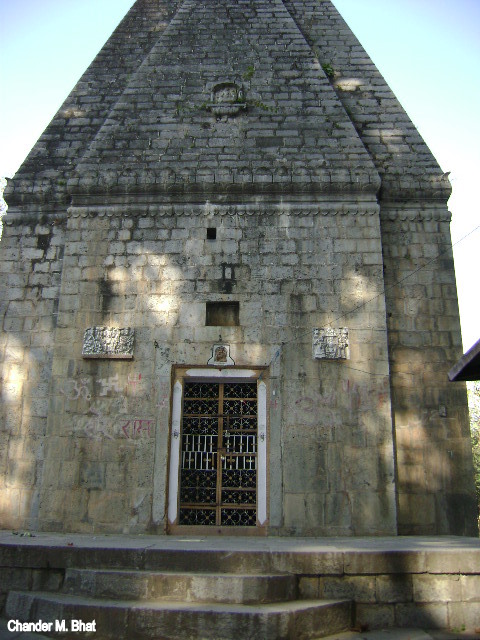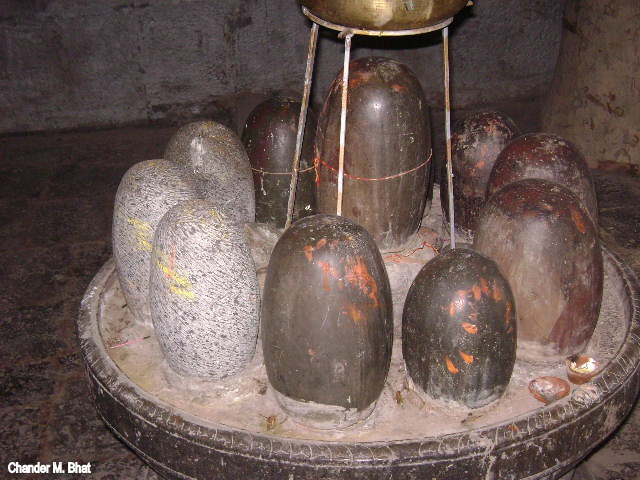Vijeshwer Temple, Bijbehara
Vejibror -
An Ancient Religious Place
by Chander M. Bhat
Bijbehara town is situated on the banks of the Vitasta (Jhelum) with the
Srinagar-Jammu highway passing through it, some 8 km from Anantnag enroute
Srinagar. Vitasta passes the ancient tirthas of Vijayesvara
(Bijbehara) and Cakradhara (Chakdhar); both these temples
were ravaged and destroyed by Sikandar Butshikan. Bijbehara was an
ancient seat of learning and in ancient times there was a University where
learners flocked to satiate their thirst for learning and scholarship. The dome
of the temple at Bijbehara was so high that its shadow was believed to be fall
up to Mattan Vodur and Awantipura.

Front View of the main temple
It is said to have been founded by King Vijaya (K.E. 2986-94), who was a local
nobleman, around the shrine of Vijayeshvara. The shrine however, existed long
before, as Ashoka, who prededed Vijaya, had boult a stone enclosure around it
and built two Asokesvara temples within the same. Being on the way to Mattan,
the shrine of the Sun-god, Shri Amarnath Cave and to several passes leading
across the Pir Panchal to the plains, the town attracted many, including leaders
of troops who caused suffering. Kalasa (1063-89 AD.) set fire to the residence
of his father Ananta who had retired to Vijayesvara.
The town, says Raj Tarangni, was reduced to ashes. There was considerable
military activity in Vijeyesvara in Kalhana’s own time. The present temple was
built by Maharaja Gulab Singh using stones from the ruins of the ancient shrine
of Vijayeshwari.
The shrine, dedicated to the god of victory, is known as vijayesvara, and the
area around it as Vijaesvarksetra. The Kashmiri name Vejbror is derived from
Vijayabhattaraka (the suffix bhattaraka meaning ‘god’). Bhattaraka has been
contracted to bror, as in Bhattarakanadvala (Kashmiri Brarinambal). Vijibror has
become Bijbehara for official records.1

Sanctum Sanctorum
There
is a mention of this place in Nilmatpurana also as under:
Gangodbheda, according to Kalhama and Nilmatpurankara was a very sacred place
under the foot of the Bheda Mountain of the Peer Panjal Range in western
Kashmir. Gangodbheda Mahatmya gives a vivid description of this sacred place and
the days of its pilgrimage. It also gives an account of its origin. Rishi
Palustya, doing a long penance in the land of Sati, had made the divine Ganga
gust forth near him from Mount Himvat for the purpose of his sacrifice. After
completing his worship, the sage wishes to discharge the river. He was stopped
by a divine voice of Goddess Saraswati from the sky. She told the saint that the
stream has its source in the mountain in the forest called Bheda and at place
would arise the holy Gangodbheda on the top of hill where the ground level
extended; a great pond full of pure water would be formed without a dam and
removed from the water of torrents.
At its eastern foot, a stream called Abheya, a purifier from all sins is to
issue which neither fails to flow nor leaps down over the steep slope. The
divine voice then informed the Rishi that the holy Gnaga would manifest itself
in this shape only for 10 days each month, flowing for the remainder period both
the heaven and the hell. At the same time, he is granted a boon. Palustya, there
upon praised the spiritual powers of the river and prayed that it might rest for
every by his side. His boon was granted and the Gangodbheda Tirtha was created.
To obtain the slight of the Goddess whose voice he had heard, the Rishi
undertook a hard penance. After a thousand years Saraswati - Goddess of knowledge
appeared to him from the sky in the form of a flamingo. Having been worshipped
by him on the 8th and 9th he bright half of Chaitra the
Goddess explained her sixfold nature. With reference to this, the sage gave her
the name of Bheda and proceeded to worship her as Hanswageshwari…Bheda on 14th
and 15th of bright fortnight of Chaitra. Eversince the Goddess has
been worshipped at the Gangodbheda Tirtha on the 8th, 9th,
14th and 15th day of the bright fortnight of Chaitra.
The Gangodbheda Mahatmya also mentions about a neighbouring shrine of Govardhana
Vishnu near which no snow ever falls for a distance. A miraculous image of Yama,
called Aujas set up for the Rishi at the same place, is also referred to.2
There are other shrines in Bijbehara town as Zaya Mata and Vezja Mata, both the
shrines are on the hillock, on the right side of national highway. The temple of
Vezya Devi was damaged in the year 1947 and at present there are no remains of
the temple. The Shrine of Mata Zaya Devi was ransacked during the communal
riots of 1986 but the then governor of J & K state restored the murties in this
temple also along with the other two temples viz old Vijeshwar temple & New
Vijeshwer temple which too were looted and ransacked. One Kah Kah Pal used to
be in the lawns of new Vijeshwer temple but the same is missing.
Notes and References:
-
Place Names in Kashmir by B.K. Raina and S.L. Sadhu published by Bharatiya Vidya
Bhavan, Mumbai and Indira Gandhi National Centre for the Arts, New Delhi, 2000
edition.
-
Bujbror - An Ancient Religious Place by Sh. P.N. Bhat published in Koshur Samachar.
-
Encyclopedia: Kashmiri Pandit Culture and Heritage by C.L. Kaul, published by
Ansh Publications, New Delhi, 2009 edition.
-
Interview dated: 23.05.2010 with Shri P.N. Koul son of Shri Poshkar Nath Koul,
resident of Bijbehara presently residing at Buta Nagar, Jammu.
Image Gallery:
http://ikashmir.net/gallery/categories.php?cat_id=231
| 